Genetically modified cell and process for use of said cell
a technology of gene-modified cells and process methods, applied in foreign genetic material cells, enzymes, bacteria peptides, etc., can solve the problems of long process time or alternative measures, and achieve the effect of improving bioproduction
- Summary
- Abstract
- Description
- Claims
- Application Information
AI Technical Summary
Benefits of technology
Problems solved by technology
Method used
Image
Examples
examples
General Methodology
[0146]Strains and Plasmids
[0147]Pseudomonas putida S12 (ATCC 700801) was used as the host for expression of genes from Cupriavidus basilensis HMF14 (Wierckx et al., 2010; Koopman et al. 2010a) and Methylobacterium radiotolerans JCM 2831 (=ATCC 27329=DSM 1819; genome sequence available at http: / / genome.jgi-psf.org / metra / metra.home.html). Escherichia coli strains DH5α or TOP10 (Invitrogen) were used for general cloning purposes.
[0148]For episomal expression of C. basilensis or M. radiotolerans genes either the pUCP22-derived pJT′mcs (Koopman et al., 2010a) or pJNNmcs(t) (Wierckx et al., 2008), or the pBBR1MCS-derived pBT′mcs (Koopman et al., 2010a) was used. In pJT′mcs and pBT′mcs the expression of the target gene is driven from the constitutive tac promoter. In pJNNmcs(t) the expression is driven from the salicylate inducible NagR / PnagAa expression cassette.
[0149]Media & Culture Conditions
[0150]Mineral salts medium (MM) was used as a defined medium. MM contained th...
example i
Co-Expression of HmfH and HmfT1 Improves FDCA Production in P. putida S12
[0161]The hmfT1 gene (formerly designated mfsl (Koopman et al., 2010a); SEQ ID NO: 7) was amplified from genomic DNA of Cupriavidus basilensis HMF14 by PCR using primers hmfT1(f) (SEQ ID NO: 13) and hmfT1(r) (SEQ ID NO: 14). The PCR product was introduced as a 1359-bp EcoRI-NheI fragment in pJNNmcs(t) yielding pJNNhmfT1(t). The hmfH gene (SEQ ID NO: 11) including its native ribosome binding site (RBS) was amplified by PCR from genomic DNA of C. basilensis HMF14 using primers FN23 (SEQ ID NO 15) and FN24 (SEQ ID NO: 16). The PCR product was cloned as a 1777-bp EcoRI fragment in pBT′mcs yielding plasmid pBT′hmfH. Plasmids pBT′hmfH and pJNNhmfT1(t) were successively introduced into P. putida S12, yielding P. putida S12_B38.
[0162]P. putida S12_B38 was cultured in fed-batches as described in the general methodology section. In the batch phase, a cell density of approximately 3 g CDW / 1 was achieved after which the gl...
example ii
Co-Expression of HmfH and a Polypeptide from Methylobacterium radiotolerans JCM 2831 Improves FDCA Production in P. putida S12
[0164]The gene with locus tag mrad2831_4728 (SEQ ID: 9) was amplified from genomic DNA of Methylobacterium radiotolerans JCM2831 by PCR using primers Mrad(f) (SEQ ID NO: 17) and Mrad(r) (SEQ ID NO: 18). The PCR product was introduced as a 1381-bp EcoRI-NheI fragment in pJNNmcs(t) yielding pJNN_Mrad(t). Plasmids pBT′hmfH (see Example I) and pJNN_Mrad(t) were successively introduced into P. putida S12, yielding P. putida S12_B51.
[0165]P. putida_B51 was cultured in shake flasks on mineral salts medium (4× buffer strength) supplemented with 1 g / l yeast extract, 80 mM glycerol, 2 mM glucose, 100 μM Na-salicylate, 50 μg / ml kanamycin and 10 μg / ml gentamicin. As control strain, P. putida S12_B38 was used (see Example I). After overnight culturing, the cultures were supplemented with 80 mM glycerol and 100 μM Na-salicylate. Subsequently, approximately 10 mM HMF was ad...
PUM
| Property | Measurement | Unit |
|---|---|---|
| temperature | aaaaa | aaaaa |
| temperature | aaaaa | aaaaa |
| temperature | aaaaa | aaaaa |
Abstract
Description
Claims
Application Information
 Login to View More
Login to View More - R&D
- Intellectual Property
- Life Sciences
- Materials
- Tech Scout
- Unparalleled Data Quality
- Higher Quality Content
- 60% Fewer Hallucinations
Browse by: Latest US Patents, China's latest patents, Technical Efficacy Thesaurus, Application Domain, Technology Topic, Popular Technical Reports.
© 2025 PatSnap. All rights reserved.Legal|Privacy policy|Modern Slavery Act Transparency Statement|Sitemap|About US| Contact US: help@patsnap.com



